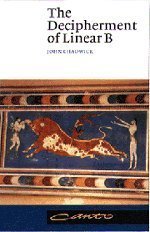What do you think?
Rate this book


164 pages, Paperback
First published January 1, 1958
Looked at from the point of view of our modern alphabets it may well seem strange that the Greeks of the Mycenaean Age were content with so ill-adapted a system. But we must remember, and the evidence goes on increasing, that the Mycenaeans never used Linear B except for accounts, inventories and similar brief notes; there is no example of continuous prose, which would demand a system providing an accurate notation of inflexional elements; the script is appropriate to its actual use, which is no more than an elaborate kind of mnemonic device.While the book comes across as dry unless one has a photocopy of the appendixes in front of him or her while reading the text, it is one of the great true tales of detection of the last hundred years.